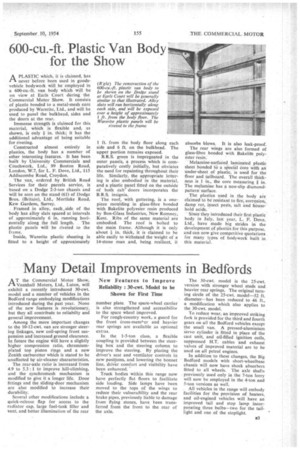600-cu.-ft. Plastic Van Body for the Show
Page 37

If you've noticed an error in this article please click here to report it so we can fix it.
A PLASTIC which, it is claimed, has
never before been used in goodsvehicle bodywork will be employed in a 600-cu.-ft. van body which will be on view at Earls Court during the Commercial Motor Show. It consists of plastic bonded to a metal-mesh core produced by Warerite, Ltd., and will be used to panel the bulkhead, sides and the doors at the rear.
Immense strength is claimed for this material, which is flexible and, as shown, is only in. thick; it has the additional advantage of being suitable for riveting.
Constructed almost entirely in plastics, the body has a number of other interesting features. It has been built by University Commercials and Coachwork, Ltd., 99 Boston Road, London, W.7, for L. F. Dove, Ltd., 115 Addiscombe Road, Croydon.
The van, ordered by British Road Services for their parcels service, is based on a Dodge 2-3-ton chassis and will be seen on the stand (61) of Dodge Bros. (Britain), Ltd., Mortlake Road, Kew Gardens, Surrey.
Framed in alloy, each,..side of the body has alloy slats spaced at intervals of approximately 6 in. running hori zontally along the full length. The plastic panels will be riveted to the frame.
Inside, Warerite plastic sheeting is fitted to a height of approximately
1 ft. from the body floor along each side and 6 ft. on the bulkhead. The upper portion remains exposed.
B.R.S. green is impregnated in the outer panels, a process which is comparatively costly initially, but obviates the need for repainting throughout their life. Similarly, the appropriate lettering is also embodied in the material, and a plastic panel fitted on the outside of both cab doors incorporates the B.R.S. insignia.
The roof, with guttering, is a onepiece moulding in glass-fibre bonded with Bakelite polyester resin produced by Bon-Glass Industries, New Romney, Kent. Ribs of the same material are embodied. The roof is bolted to the main frame. Although it is only about in. thick, it is claimed to be able easily to Withstand the weight of a 14-stone man and, being resilient, it absorbs blows. It is also leak-proof. The rear wings are also formed of glass-fibre bonded with Bakelite polyester resin.
Melamine-surfaced laminated plastic sheet banded 'to a special Core with an under-sheet of plastic, is used for the floor and .tailboard. The overall thickness is 1 in., the core measuring in. The melamine has a non-slip diamondpattern surface.
The plastics used in the body are claimed to be resistant to fire, corrosion„ damp rot, insect pests, salt and lieu's& hold acids.
Since they introduced their first plastic body in July, last year, L. F. Dove, Ltd., have made big strides in the development of plastics for this purpose. and can now give competitive quotations for many types of bodywork built in this material.




















































































